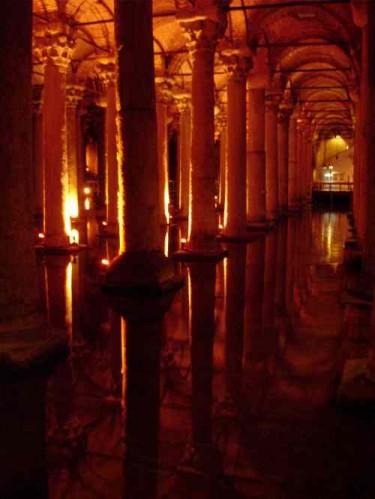It’s hard to describe just how rich Istanbul’s history is. Everyone knows that it’s the city where East meets West, literally: part is in Europe and part is in Asia, with the Bosphorus Strait dividing the two. I was enthralled by Hagia Sophia — or Ayasofia, in Turkish — the great church built by the Byzantine Emperor Justinian in 537 (it’s now a museum). Across the street from it is the Sultanahmet Mosque (also called the Blue Mosque), built by Sultan Ahmet I in 1617, famous for its stunning tiled interior and six minarets. But the most surprising place, to me, was a treasure that was forgotten for centuries beneath the bustling city: the Basilica Cistern.
At roughly the same time Hagia Sophia was constructed, Justinian expanded and rebuilt the cistern, which had been created during Emperor Constantine’s reign. While its purpose was purely functional — the cistern served as a reservoir for the city, capable of holding 27 million gallons of water — its form was a work of art. Justinian’s builders reclaimed 336 columns from local Roman ruins to support the cathedral-like brick ceiling. It’s hard to believe, but this subterranean Byzantine treasure was forgotten in the Ottoman age. Rediscovered in the 20th century, it was repaired and opened as a tourist attraction in 1987 (after being used in the 1963 James Bond film From Russia With Love).
It seemed to me after visiting the Basilica Cistern (Yerebatan Sarnici in Turkish, literally ‘sunken palace’), that Istanbul was a rare city in being able to overlook such a gem for so long. But that’s the thing about Istanbul — there is an abundance of everything. This can be enthralling, as you wander through its historic places, or confusing, as it was in the case of restaurants. Sultanahmet is filled with restaurants, most of which have men in front who try to lure you in, often loudly and aggressively. The approach didn’t whet my appetite, and it made me seek alternatives. In a pedestrian alleyway off the crowded Divan Yolu, I found one restaurant, Amedros, where the host out front smiled and nodded politely. I showed him my Turkish celiac card and he became curiously excited. He showed the card to a waiter, who became equally animated. They assured me that the kitchen would be able to make a safe meal for me. One added, “This card, it is wonderful.”
I discovered over dinner why they were so thrilled with the celiac card. A few weeks earlier, a tourist who had a food allergy had dined at the restaurant, but she hadn’t told the restaurant staff about her issues and they watched, horrified, as she had a serious reaction to the peppers in her dish. The staff was relieved — grateful even — to find out what my dietary issues were and were happy to accommodate them. The menu at Amedros is available in English, and it offers detailed descriptions of each dish, but you can never count on avoiding an allergen by ordering something that just looks safe. My meal there was simple — a green salad, followed by grilled sea bass and veggies, all paired with a light, white Turkish wine — but it was safe (and delicious!). The staff actually thanked me at the end of the meal for telling them about celiac disease. It was a wonderful evening, and a reminder that Istanbul is full of surprises.
Amedros [address] Hoca Rüstem Sokak 7, off Divan Yolu, Sultanahmet, Istanbul [tel] 90 212 522 83 56 [web] www.amedroscafe.com

